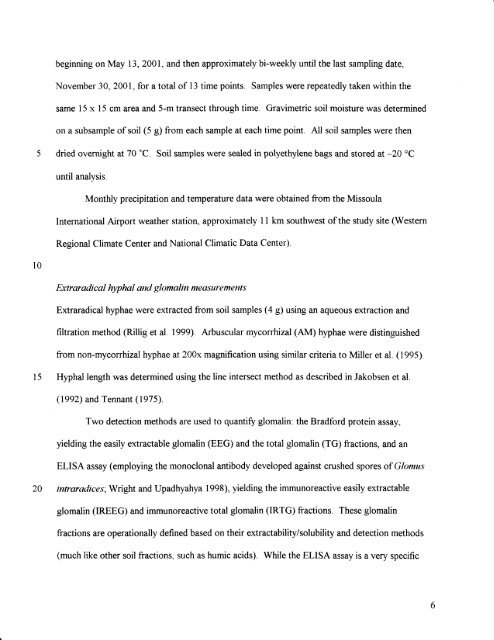Final Report - Center for Invasive Plant Management
Final Report - Center for Invasive Plant Management
Final Report - Center for Invasive Plant Management
You also want an ePaper? Increase the reach of your titles
YUMPU automatically turns print PDFs into web optimized ePapers that Google loves.
eginning on May 13, 2001, and then approximately bi-weekly until the last sampling date,November 30, 2001, lor a total of l3 time points. Samples were repeatedly taken within thesame i 5 x 15 cm area and 5-m transect through time. Gravimetric soil moisture was determinedon a subsample of soil (5 g) from each sample at each time point. All soil samples were thendried overnight at 70 'C. Soil samples were sealed in polyethylene bags and stored at *20 oCuntil analysis.lt{onthly precipitation and temperature data were obtained from the MissoulaInternational Airport rveather station, approximately I I km southwest of the study site (WesternRegional Climate <strong>Center</strong> and National Climatic Data <strong>Center</strong>).l0Extraradi cal hyphal and glomali n nreasurementsExtraradical hyphae were extracted from soil samples (4 g) using an aqueous extraction andfiltration method (Rillig et al. 1999). Arbuscular mycorrhizal (AM) hyphae were distinguishedfrom non-mycorrhizal hyphae at 200x magnification using similar criteria to Miller et al. (1995).l5Hyphal length was determined using the line intersect method as described in Jakobsen et al.(1992) and Tennant (1975).Two detection methods are used to quantifu glomaiin: the Bradlord protein assay,yielding the easily extractable -qlomalin(EEG) and the total glomalin (TG) liactions, and anELISA assay (employing the monoclonal antibody developed against crushed spores of Glnmus2Aintrsradices; Wright and Upadhyahya 1998), yielding the irnrnunoreactive easily extractableglomalin (IREEG) and immunoreactive total glomalin (IRTC) fractions. These glomalinfractions are operationally defined based on their extractabilitylsolubility and detection methods(much like other soil fractions" such as humic acids). While the ELISA assay is a very specific
















